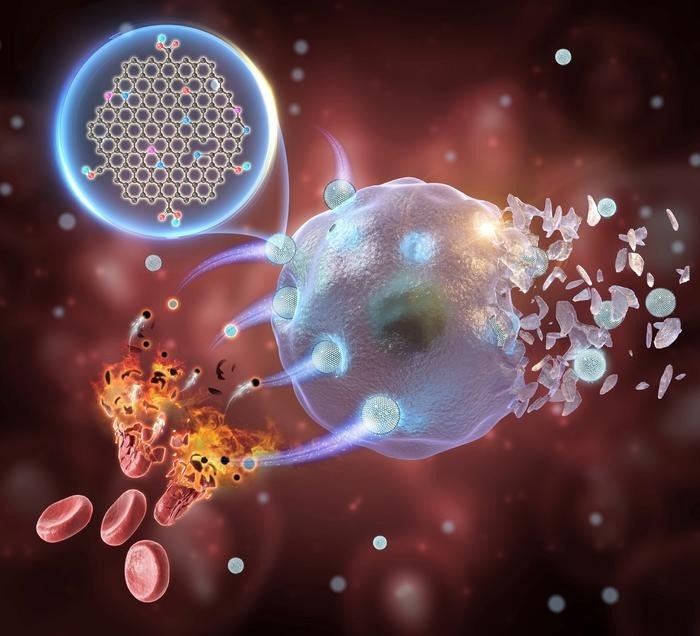A metal-free nanozyme based on graphene quantum dots (GQDs) for extremely effective tumor chemodynamic treatment (CDT) has been developed by a research team headed by Prof. Hui Wang from the Hefei Institutes of Physical Science (HFIPS) of the Chinese Academy of Sciences and reported in Matter.
 Schematic illustration showing the role of GQDs, derived from erythrocyte membranes, as peroxidase--mimic enzyme for tumor catalytic therapy. Image Credit: FHIPS
Schematic illustration showing the role of GQDs, derived from erythrocyte membranes, as peroxidase--mimic enzyme for tumor catalytic therapy. Image Credit: FHIPS
When it comes to resolving the toxicity issues related to metal-based nanozymes in tumor CDT, GQDs offer a viable and affordable solution. However, GQDs’ low catalytic activity has made it difficult for them to be used in clinical settings, especially in harsh catalytic environments.
The obtained GQDs, which are made from red blood cell membranes, are highly effective in treating tumors with few side effects. One of the advantages is that they are metal-free. In addition, they function as excellent peroxidase-like biocatalysts.
Hongji Liu, Professor, Hefei Institutes of Physical Science (HFIPS), Chinese Academy of Sciences
The researchers logically created GQDs utilizing a diatomic doping method to improve the catalytic activity of the GQD-based nanocatalytic adjuvant. Compared to single heteroatom doping, the synergistic electron impact of adding nitrogen and phosphorus to graphene quantum dots (GQDs) can produce highly localized states close to the Fermi level, enabling efficient enzymatic activity.
It has been demonstrated that the erythrocyte membrane-derived GQDs exhibit remarkable peroxidase-mimicking activity. Consequently, the GQDs exhibit remarkable efficacy in eliciting ferroptosis and apoptosis in cancer cells in vitro. With no off-target adverse effects and a tumor inhibition rate of up to 77.71% for intravenous injection and 93.22% for intratumoral injection, they also specifically target tumors.
With the potential to be a powerful biocatalyst for safe cancer therapy, this drug-free, target-specific, and biologically benign nanozyme has considerable promise.
Journal Reference:
Liu, H., et. al. (2023) Graphene quantum dots as metal-free nanozymes for chemodynamic therapy of cancer. Matter. doi:10.1016/j.matt.2023.12.005.